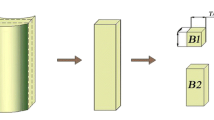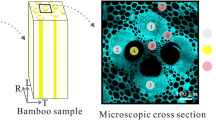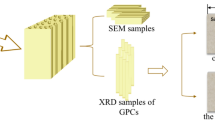Abstract
The variation of cellulose microfibril orientation within the bamboo has been confirmed to be one of the critical factors exerting a strong influence on the mechanical properties of bamboo fibers, which is regarded as the response of the cell wall to the internal and external stimulus. In this paper, the radial gradient variation of the cellulose supramolecular structures of bamboo culm was systematically studied by XRD and the linear polarized confocal Raman microspectroscopy to deepen the understanding of the origin of bamboo micromechanics and its functionally graded properties. XRD analysis indicated that bamboo yellow (By) had the isotropic crystallite arrangements, while bamboo timber (Bt) and bamboo green (Bg) displayed preferred orientation of crystals. Moreover, both the crystallinity and crystallite sizes notably grew from the inner By to the Bg. At cell wall level, the variations in the distribution of microfibril orientation were visualized by Raman imaging, with the fiber secondary wall areas adjacent to compound middle lamella displaying higher Raman intensity. Furthermore, Raman band ratio (I1095/I2939) was used to predict the microfibril angle (MFA) in different cell wall types and morphologically distinct cell wall layers semi-quantitatively. The results showed that the ratio was the highest in parenchyma, followed by narrow layer of fiber wall, and the lowest in the broad layer, which indicated the high MFA in the parenchyma. Interestingly, the ratio decreased along the successive and alternating broad and narrow lamellae of fiber wall, in accordance with cell wall micromechanical trend.




Similar content being viewed by others
References
Abe K, Yano H (2009) Comparison of the characteristics of cellulose microfibril aggregates of wood, rice straw and potato tuber. Cellulose 16:1017–1023. https://doi.org/10.1007/s10570-009-9334-9
Agarwal UP (2006) Raman imaging to investigate ultrastructure and composition of plant cell walls: distribution of lignin and cellulose in black spruce wood (Picea mariana). Planta 224(5):1141–1153. https://doi.org/10.1007/s00425-006-0295-z
Agarwal U, Atalla R (1986) In-situ Raman microprobe studies of plant cell walls: Macromolecular organization and compositional variability in the secondary wall of Picea mariana (Mill.) BSP. Planta 169:325–332. https://doi.org/10.1007/bf00392127
Agarwal UP, Ralph SA (1997) FT-Raman spectroscopy of wood: identifying contributions of lignin and carbohydrate polymers in the spectrum of black spruce (Picea mariana). Appl Spectrosc 51:1648–1655. https://doi.org/10.1366/0003702971939316
Agarwal UP, Sabo R, Reiner RS, Clemons CM, Rudie AW (2012) Spatially resolved characterization of cellulose nanocrystal–polypropylene composite by confocal raman microscopy. Applied Spectro 66(7):750–756. https://doi.org/10.1366/11-06563
Agarwal UP, Reiner RS, Ralph SA (2013) Estimation of cellulose crystallinity of lignocelluloses using near-IR FT-Raman spectroscopy and comparison of the raman and Segal-WAXS methods. J Agric Food Chem 61:103–113. https://doi.org/10.1021/jf304465k
Agarwal UP, Ralph SA, Reiner RS, Baez C (2016) Probing crystallinity of never-dried wood cellulose with Raman spectroscopy. Cellulose 23(1):125–144
Agarwal UP, Ralph SA, Reiner RS, Baez C (2018) New cellulose crystallinity estimation method that differentiates between organized and crystalline phases. Carbohyd Polym 190:262–270
Agarwal UP, Ralph SA, Baez C, Reiner RS (2021) Contributions of crystalline and noncrystalline cellulose can occur in the same spectral regions: evidence based on Raman and IR and its implication for crystallinity measurements. Biomacromol 22:1357–1373. https://doi.org/10.1021/acs.biomac.0c01389
Ahvenainen P, Dixon PG, Kallonen A, Suhonen H, Gibson LJ, Svedström K (2017) Spatially-localized bench-top X-ray scattering reveals tissue-specific microfibril orientation in Moso bamboo. Plant Methods 13:1–12. https://doi.org/10.1186/s13007-016-0155-1
An X, Liu J, Liu L, Zhang H, Nie S, Cao H, Xu Q, Liu H (2020) Improving the flexibility of bamboo mechanical pulp fibers for production of high soft tissue handsheets. Ind Crop Prod 150:112410. https://doi.org/10.1016/j.indcrop.2020.112410
Chen S, Zhang X, Ling Z, Xu F (2017) Characterization of the micromorphology and topochemistry of poplar wood during mild ionic liquid pretreatment for improving enzymatic saccharification. Molecules 22:115. https://doi.org/10.3390/molecules22010115
Chen M, Ye L, Li H, Wang G, Chen Q, Fang C, Dai C, Fei B (2020) Flexural strength and ductility of moso bamboo. Constr Build Mater 246:118418. https://doi.org/10.1016/j.conbuildmat.2020.118418
Chen J, Ren Y, Liu W, Wang T, Chen F, Ling Z, Yong Q (2021) All-natural and biocompatible cellulose nanocrystals films with tunable supramolecular structure. Int J Bio Macro 193:1324–1331
Cheng G, Zhang X, Simmons B, Singh S (2015) Theory, practice and prospects of X-ray and neutron scattering for lignocellulosic biomass characterization: towards understanding biomass pretreatment. Energ Environ Sci 8:436–455. https://doi.org/10.1039/C4EE03147D
Cosgrove DJ (2005) Growth of the plant cell wall. Nat Rev Mol Cell Bio 6:850–861. https://doi.org/10.1038/nrm1746
Emons AMC (1994) Winding threads around plant cells: a geometrical model for microfibril deposition. Plant Cell Environ 17(1):3–14
French AD (2014) Idealized powder diffraction patterns for cellulose polymorphs. Cellulose 21:885–896. https://doi.org/10.1007/s10570-013-0030-4
French AD, Santiago Cintrón M (2013) Cellulose polymorphy, crystallite size, and the segal crystallinity index. Cellulose 20:583–588. https://doi.org/10.1007/s10570-012-9833-y
Gierlinger N, Luss S, König C, Konnerth J, Eder M, Fratzl P (2010) Cellulose microfibril orientation of Picea abies and its variability at the micron-level determined by Raman imaging. J Exp Bot 61:587–595. https://doi.org/10.1093/jxb/erp325
Hao H, Tam LH, Lu Y, Lau D (2018) An atomistic study on the mechanical behavior of bamboo cell wall constituents. Compos Part B Eng 151:222–231. https://doi.org/10.1016/j.compositesb.2018.05.046
Holzwarth U, Gibson N (2011) The Scherrer equation versus the “Debye-Scherrer equation.” Nat Nanotechnol 6:534–534. https://doi.org/10.1038/nnano.2011.145
Hu K, Huang Y, Fei B, Yao C, Zhao C (2017) Investigation of the multilayered structure and microfibril angle of different types of bamboo cell walls at the micro/nano level using a LC-PolScope imaging system. Cellulose 24:4611–4625. https://doi.org/10.1007/s10570-017-1447-y
Huang Y, Fei B, Wei P, Zhao C (2016) Mechanical properties of bamboo fiber cell walls during the culm development by nanoindentation. Ind Crop Prod 92:102–108. https://doi.org/10.1016/j.indcrop.2016.07.037
Huang S, Makarem M, Kiemle SN, Hamedi H, Sau M, Cosgrove DJ, Kim SH (2018) Inhomogeneity of cellulose microfibril assembly in plant cell walls revealed with sum frequency generation microscopy. J Phys Chem B 122:5006–5019. https://doi.org/10.1021/acs.jpcb.8b01537
Jin K, Ling Z, Jin Z, Ma J, Yang S, Liu X, Jiang Z (2021) Local Variations in carbohydrates and matrix lignin in mechanically graded bamboo culms. Polymers 14:143. https://doi.org/10.3390/polym14010143
Li Z, Chen C, Mi R, Gan W, Dai J, Jiao M, Xie H, Yao Y, Xiao S, Hu L (2020) A strong, tough, and scalable structural material from fast-growing bamboo. Adv Mater 32:1906308. https://doi.org/10.1002/adma.201906308
Lin Q, Huang Y, Yu W (2020) An in-depth study of molecular and supramolecular structures of bamboo cellulose upon heat treatment. Carbohyd Polym 241:116412. https://doi.org/10.1016/j.carbpol.2020.116412
Ling Z, Wang T, Makarem M, Santiago Cintrón M, Cheng H, Kang X, Bacher M, Potthast A, Rosenau T (2019) Effects of ball milling on the structure of cotton cellulose. Cellulose 26:305–328. https://doi.org/10.1007/s10570-018-02230-x
Ling Z, Guo Z, Huang C, Yao L, Xu F (2020) Deconstruction of oriented crystalline cellulose by novel levulinic acid based deep eutectic solvents pretreatment for improved enzymatic accessibility. Bioresource Technol 305:123025. https://doi.org/10.1016/j.biortech.2020.123025
Ma J, Zhou X, Ma J, Ji Z, Zhang X, Xu F (2014) Raman microspectroscopy imaging study on topochemical correlation between lignin and hydroxycinnamic acids in Miscanthus sinensis. Microsc Microanal 20:956–963. https://doi.org/10.1017/S1431927614000658
Nishiyama Y, Langan P, Chanzy H (2002) Crystal structure and hydrogen-bonding system in cellulose Iβ from synchrotron X-ray and neutron fiber diffraction. J Am Chem Soc 124:9074–9082. https://doi.org/10.1021/ja0257319
Polko J, Kieber JJ (2019) The regulation of cellulose biosynthesis in plants. Plant Cell 31(2):282–296. https://doi.org/10.1105/tpc.18.00760
Pope CG (1997) X-ray diffraction and the Bragg equation. J Chem Educ 74:129. https://doi.org/10.1021/ed074p129
Purusatama BD, Choi JK, Lee SH, Kim NH (2019) Microfibril angle, crystalline characteristics, and chemical compounds of reaction wood in stem wood of Pinus densiflora. Wood Sci Technol 54(1):123–137
Rasheed M, Jawaid M, Parveez B, Zuriyati A, Khan A (2020) Morphological, chemical and thermal analysis of cellulose nanocrystals extracted from bamboo fibre. Int J Biol Macromol 160:183–191
Ren W, Guo F, Zhu J, Cao M, Wang H, Yu Y (2021) A comparative study on the crystalline structure of cellulose isolated from bamboo fibers and parenchyma cells. Cellulose 28:5993–6005. https://doi.org/10.1007/s10570-021-03892-w
Ren W, Zhu J, Guo F, Guo J, Wang H, Yu Y (2022) Estimating cellulose microfibril orientation in the cell wall sublayers of bamboo through dimensional analysis of microfibril aggregates. Ind Crop Prod 179:114677. https://doi.org/10.1016/j.indcrop.2022.114677
Sahlberg U, Salmén L, Oscarsson A (1997) The fibrillar orientation in the S2-layer of wood fibres as determined by X-ray diffraction analysis. Wood Sci Technol 31:77–86. https://doi.org/10.1007/BF00705923
Sluiter A, Hames B, Ruiz R, Scarlata C, Sluiter J, Templeton D, Crocker D (2010) Determination of structural carbohydrates and lignin in biomass. Lab Anal Proced 1617:1–16
Sun L, Singh S, Joo M, Vega-Sanchez M, Ronald P, Simmons BA, Adams P, Auer M (2016) Non-invasive imaging of cellulose microfibril orientation within plant cell walls by polarized Raman microspectroscopy. Biotechnol Bioeng 113:82–90. https://doi.org/10.1002/bit.25690
Suzuki K, Itoh T (2001) The changes in cell wall architecture during lignification of bamboo, Phyllostachys aurea Carr. Trees 15:137–147. https://doi.org/10.1007/s004680000084
Thomas LH, Forsyth VT, Martel A, Grillo I, Altaner CM, Jarvis MC (2015) Diffraction evidence for the structure of cellulose microfibrils in bamboo, a model for grass and cereal celluloses. BMC Plant Biol 15:1–7. https://doi.org/10.1186/s12870-015-0538-x
Thomas LH, Altaner CM, Forsyth VT, Mossou E, Kennedy CJ, Martel A, Jarvis MC (2021) Nanostructural deformation of high-stiffness spruce wood under tension. Sci Rep. https://doi.org/10.1038/s41598-020-79676-2
Voiniciuc C, Pauly M, Usadel B (2018) Monitoring polysaccharide dynamics in the plant cell wall. Plant Physiol 176:2590–2600. https://doi.org/10.1104/pp.17.01776
Wang F, Shao Z (2020) Study on the variation law of bamboo fibers’ tensile properties and the organization structure on the radial direction of bamboo stem. Ind Crop Prod 152:112521. https://doi.org/10.1016/j.indcrop.2020.112521
Wang Y, Leppänen K, Andersson S, Serimaa R, Ren H, Fei B (2012) Studies on the nanostructure of the cell wall of bamboo using X-ray scattering. Wood Sci Technol 46:317–332. https://doi.org/10.1007/s00226-011-0405-3
Wang X, Keplinger T, Gierlinger N, Burgert I (2014) Plant material features responsible for bamboo’s excellent mechanical performance: a comparison of tensile properties of bamboo and spruce at the tissue, fibre and cell wall levels. Ann Bot 114:1627–1635. https://doi.org/10.1093/aob/mcu180
Wang Y, Liu C, Zhao R, McCord J, Rials T, Wang S (2016) Anatomical characteristics, microfibril angle and micromechanical properties of cottonwood (Populus deltoides) and its hybrids. Biomass Bioenerg 93:72–77. https://doi.org/10.1016/j.biombioe.2016.06.011
Wiley JH, Atalla RH (1987) Band assignments in the Raman spectra of celluloses. Carbohyd Res 160:113–129. https://doi.org/10.1016/0008-6215(87)80306-3
Yang K, Li L, Lou Y, Zhu C, Li X, Gao Z (2021) A regulatory network driving shoot lignification in rapidly growing bamboo. Plant Physiol 187:900–916. https://doi.org/10.1093/plphys/kiab289
Yu HQ, Fei BH, Ren HQ, Jiang ZH, Liu XE (2008) Variation in tensile properties and relationship between tensile properties and air-dried density for Moso bamboo. Front for China 3:127–130. https://doi.org/10.1007/s11461-008-0008-9
Yu Y, Tian G, Wang H, Fei B, Wang G (2011) Mechanical characterization of single bamboo fibers with nanoindentation and microtensile technique. Holzforschung 65:113–119. https://doi.org/10.1515/hf.2011.009
Zhang T, Vavylonis D, Durachko DM, Cosgrove DJ (2017) Nanoscale movements of cellulose microfibrils in primary cell walls. Nat Plants 3(5):17056. https://doi.org/10.1038/nplants.2017.56
Zhu J, Wang H, Guo F, Salmén L, Yu Y (2021) Cell wall polymer distribution in bamboo visualized with in situ imaging FTIR. Carbohyd Polym 274:118653. https://doi.org/10.1016/j.carbpol.2021.118653
Zou L, Jin H, Lu WY, Li X (2009) Nanoscale structural and mechanical characterization of the cell wall of bamboo fibers. Mater Sci Eng C 29:1375–1379. https://doi.org/10.1016/j.msec.2008.11.007
Acknowledgements
We would like to thank the Fundamental Research Funds of ICBR (Grant No 1632022008), the National Natural Science Foundation for Youth (32001254, 32001270), the Natural Science Foundation of Jiangsu Province for Youth (BK20200797).
Author information
Authors and Affiliations
Contributions
ZL, ZJ and JFM designed the experiments; LXD and QC collected samples; ZL, LXD and QC performed the experiments. ZL, ZJ and JFM analyzed the data. ZL and ZJ wrote the manuscript. ZJ, ZL and JFM obtained funding. ZJ agrees to serve as the author responsible for contact and ensures communication. The author responsible for distribution of materials integral to the findings presented in this article in accordance with the policy described in the Instructions for Authors (https://academic.oup.com/plphys/pages/general-instructions) is: Zhi Jin (zj2015@caf.ac.cn).
Corresponding author
Ethics declarations
Competing interests
The authors declare no competing interests.
Additional information
Publisher's Note
Springer Nature remains neutral with regard to jurisdictional claims in published maps and institutional affiliations.
Supplementary Information
Below is the link to the electronic supplementary material.
Rights and permissions
Springer Nature or its licensor (e.g. a society or other partner) holds exclusive rights to this article under a publishing agreement with the author(s) or other rightsholder(s); author self-archiving of the accepted manuscript version of this article is solely governed by the terms of such publishing agreement and applicable law.
About this article
Cite this article
Ling, Z., Chen, Q., Jin, Z. et al. Gradient variations of cellulose supramolecular structures in moso bamboo culm: from nano- to microhorizons. Wood Sci Technol 57, 359–373 (2023). https://doi.org/10.1007/s00226-023-01455-9
Received:
Accepted:
Published:
Issue Date:
DOI: https://doi.org/10.1007/s00226-023-01455-9




